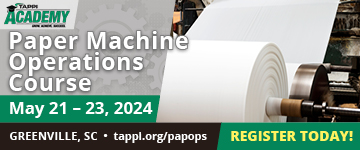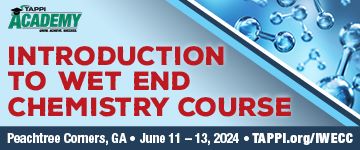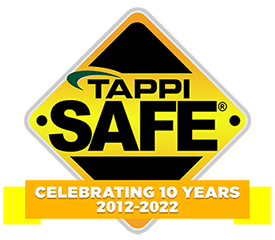 Search
Search
Use the search bar or filters below to find any TAPPI product or publication.
Filters
Content Type
Publications
Level of Knowledge
Collections
Journal articles

Magazine articles

Size distribution analysis of microstickies treated by enzyme mixtures in papermaking whitewater, TAPPI Journal March 2019
ABSTRACT: Microstickies present a formidable challenge for papermakers. Many strategies have been explored o control them. Enzyme treatment is a promising technology, but the mechanism of its action has not been determined, thus inhibiting further application of this new technology. This study investigated characteristics and size distributions of microstickies treated by esterase-cellulase mixtures. Determination of particle size and number was accomplished using a modified flow cytometer, which combined streaming capillary flow, laser-based particle size analysis and fluorescent dye tracing. The results showed that treatment of samples with enzyme mixtures induced size reduction of the larger microstickies. This effect was most dramatic for 1:1 ratios of esterase to cellulase. The treated particles were more stable than untreated ones. The smaller microstickies treated with some ratios of esterase and cellulase tended to aggregate over time.
Journal articles

Magazine articles

Controllable anisotropic properties of wet-laid hydroentangled nonwovens, TAPPI Journal March 2019
ABSTRACT: For nonwovens, fiber orientation distribution is an important structural characteristic that directly influences the anisotropic properties of the materials. Different Vslurry/Vbelt ratios were adopted to fabricate nonwovens during the wet-laid process. The results indicated that fiber orientation distribution of nonwovens can be regulated by adopting different Vslurry/Vbelt ratios owing to the web-forming principle of wet-laid techniques. Mechanical tests showed that both wet and dry tensile strength of nonwovens in different angle directions present anisotropy under different Vslurry/Vbelt ratio parameters. A liquid spreading distribution experiment proved that liquid spreading length and area of nonwovens could be manipulated using different Vslurry/Vbelt ratios in the fabrication process. Therefore, specific anisotropic properties of wet-laid hydroentangled nonwovens can be realized by controlling the process parameters for particular end-use applications.
Journal articles

Magazine articles

Sources, collection, and handling of noncondensible gases in modern kraft pulp mills
ABSTRACT: This work describes and discusses sources of noncondensible gases (NCG) in modern kraft pulp mills and modern NCG collection from process units where odor emissions can occur if these gases are released to the surroundings. A mill-wide overview of NCG sources and collection in modern pulp mills is provided. Using modern practices, malodorous gases can be collected to the extent that a pulp mill is essentially odor free. The key to limiting complaint-causing odors is prevention of these emissions during process disturbances, equipment malfunctions, operator errors, and other unforeseen occurrences.
Journal articles

Magazine articles

Editorial: The changing face of the coated paper industry, TAPPI JOURNAL January 2018
Editorial: The changing face of the coated paper industry, TAPPI JOURNAL January 2018
Journal articles

Magazine articles

Effects of a PFI refiner’s operational parameters on the swellability of recycled fiber, TAPPI Journal May 2020
ABSTRACT: This paper presents data on the effects of operational parameters (number of revolutions, linear pressure, and gap) of the PFI refiner on the swellability of recycled fiber, which was characterized by water retention value (WRV). The results showed that the increase of recycled fiber’s WRV was proportional to the number of revolutions and the linear pressure, but inversely proportional to the gap. The mathematical relation between these parameters and the fiber WRV could be described by an empirical model for gaps greater than 0.1 mm. Scanning electron microscopic images of fiber morphology showed that the basic framework of fibers could be maintained with the gap greater than 0.1 mm, but was destroyed with smaller gaps. This model provides a technical reference for quantitative control of refining treatment and an effective method for improving recycled fiber quality.
Journal articles

Magazine articles

Wheat straw as an alternative pulp fiber, TAPPI Journal January 2020
ABSTRACT: The desire to market sustainable packaging materials has led to an interest in the use of various fiber types as a raw material. It has been suggested that the use of annual crops for partial replacement of wood fiber would result in more sustainable products. Several life cycle analyses (LCA) have been performed to evaluate these claims. These LCAs provided conflicting and contradictory results because of the local conditions and the specific pulping processes investigated. Selected LCAs are reviewed and the underlying reasons for these conflicting results are analyzed.
Journal articles

Magazine articles

Equilibrium moisture content in wet pressing of paper, TAPPI Journal July 2020
ABSTRACT: Equilibrium moisture is a limiting factor in achieving high solids in the later stages of pressing or pressing low basis weight grades. We have developed a model that relates equilibrium moisture directly to the pore size distribution of fibers as measured by the solute exclusion technique. The model shows that chemical pulping and refining increase equilibrium moisture by increasing pore volume at given pore sizes in fibers, which leads to lower pressed solids and greater energy expenditure in the dryer section. Means to increase equilibrium moisture without compromising pulp strength are briefly discussed.
Journal articles

Magazine articles

Editorial: TAPPI Journal reinstates the “Technical Brief” short-form research paper, TAPPI Journal June 2019
ABSTRACT: For many years, TAPPI Journal (TJ) accepted submissions of “Technical Briefs” (also known as Technical Notes or Brief Notes) in addition to the full-length papers peer-reviewed papers that you have typically seen in more recent years. The TJ Editorial Board is once again accepting these short-form papers, as readers may have noticed in the last issue with publication of Tom Lindstrom’s short nanocellulose re-view (TAPPI Journal 18[5]: 308[2019]). Another Technical Brief appears on p. 391 of the current issue.
Journal articles

Magazine articles

Viscoelastic web curl due to storage in wound rolls, TAPPI Journal July 2020
ABSTRACT: Winding is often the final operation in a roll-to-roll manufacturing process. Web materials, i.e., materials that are thin compared to their length, are wound into rolls because this form is the only practical means to store them. The resulting bending strains and associated stresses are large for thick webs and laminates. As many webs are viscoelastic on some time scale, bending stresses lead to creep and inhomogeneous changes in length. When the web material is unwound and cut into discrete samples, a residual curvature remains. This curvature, called curl, is the inability for the web to lie flat at no tension. Curl is an undesirable web defect that causes loss of productivity in a subsequent web process. This paper describes the development and implementation of modeling and experimental tools to explore and mitigate curl in homogenous webs. Two theoretical and numerical methods that allow the prediction of curl in a web are developed: a winding software based on bending recovery theory, and the implementation of dynamic simula-tions of winding. One experimental method is developed that directly measures the curl online by taking advantage of the anticlastic bending resulting from the curl. These methods are demonstrated for a low-density polyethylene web.
Journal articles

Magazine articles

Decreased water usage in a softwood ECF bleaching sequence— full mill simulations, TAPPI JOURNAL June 2018
Decreased water usage in a softwood ECF bleaching sequence— full mill simulations, TAPPI JOURNAL June 2018






